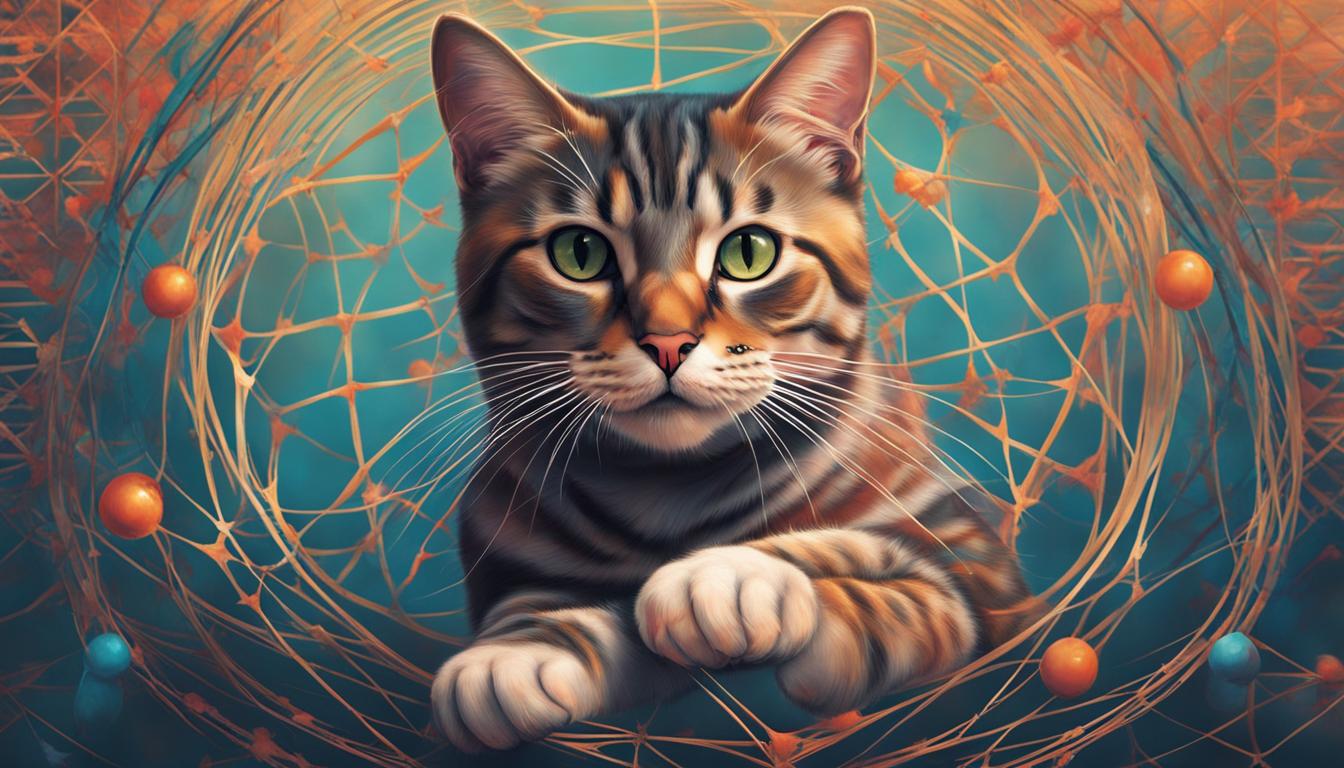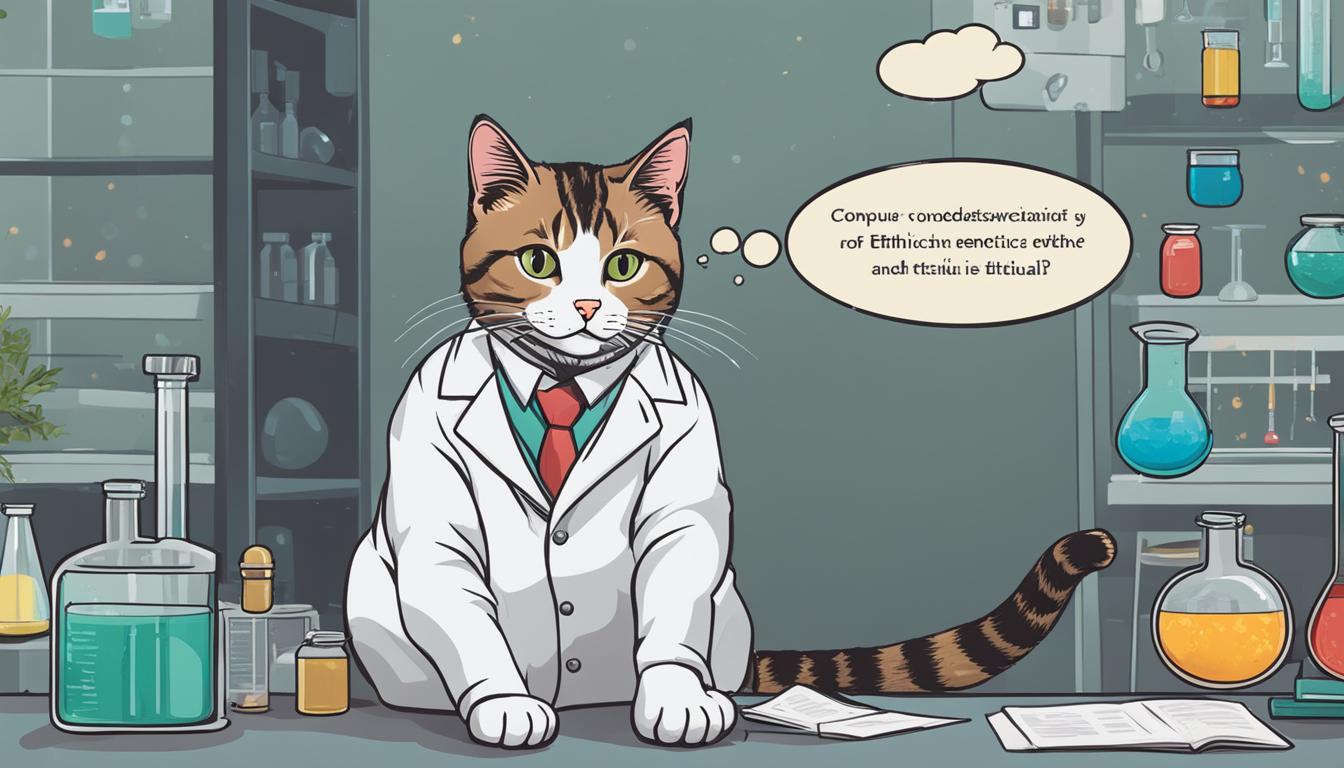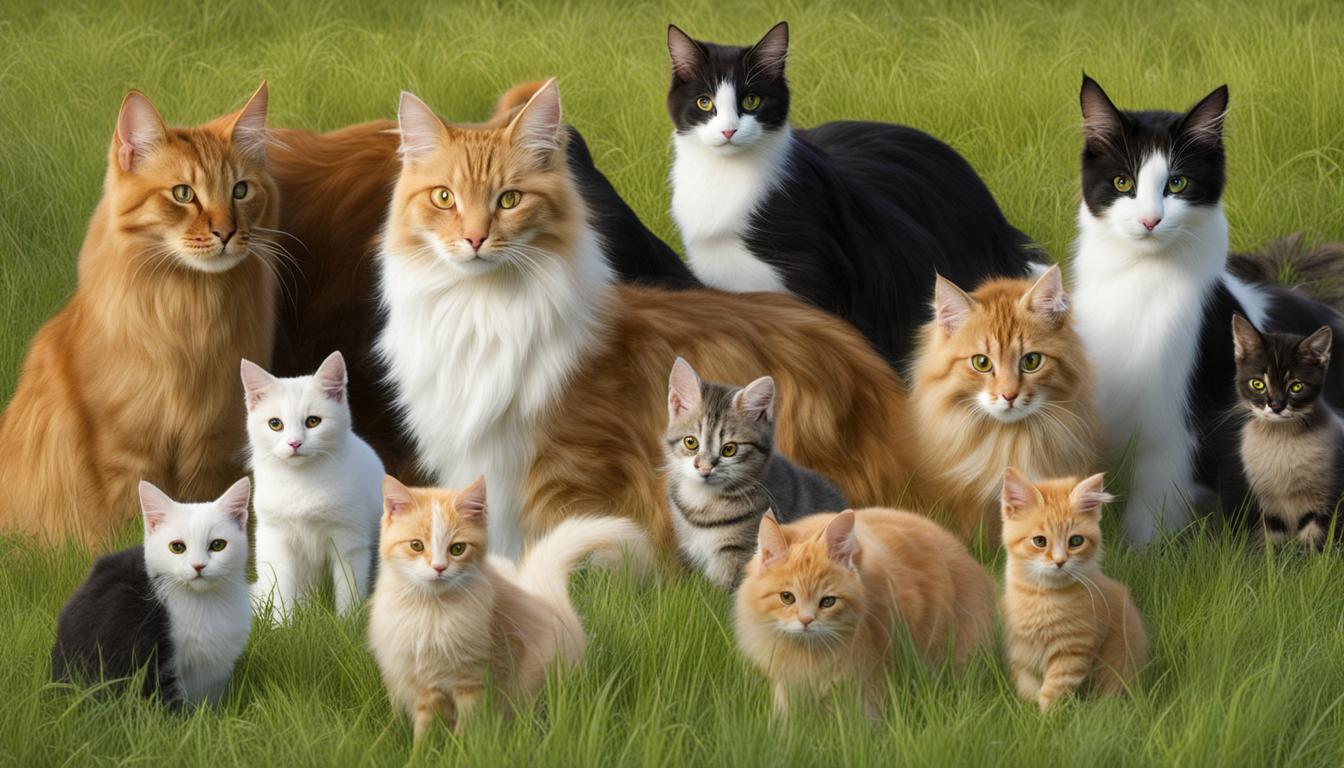Genetic disorders in cats are a fascinating and complex topic. As a cat lover, I’ve always been curious about how these conditions arise and what can be done to manage them. Genetic disorders are caused by abnormal genes that are passed down from one generation to another, leading to a range of symptoms and health issues. Whether it’s a condition that shows up at birth or one that develops later in life, understanding the symptoms and management options is crucial for the well-being of our feline friends.
Genetic disorders are more common in pedigree cats due to the selective breeding and inbreeding practices involved. Fortunately, advancements in genetic testing have revolutionized our ability to identify gene defects associated with these inherited conditions. With the help of diagnostic tests, we can now better understand the underlying causes and develop strategies to manage and minimize the impact of genetic disorders.
Key Takeaways:
- Genetic disorders in cats are caused by abnormal genes passed down from one generation to another.
- Pedigree cats are more susceptible to genetic disorders due to selective breeding and inbreeding.
- Advancements in genetic testing have made it possible to identify gene defects and develop diagnostic tests.
- Controlling genetic diseases involves understanding the mode of inheritance and utilizing DNA tests.
- Proper identification of tested cats and using reputable laboratories is crucial when performing DNA tests.
Genetic Testing and Diagnosis of Feline Genetic Disorders
Genetic testing plays a crucial role in the diagnosis of feline genetic disorders. With advances in veterinary science, DNA tests are now available to determine whether a cat is affected by a specific genetic disorder or is a carrier. These tests are particularly important for breeding programs as they help identify cats that should not be bred due to their risk of passing on the disease. It is essential to conduct genetic testing under the supervision of a veterinarian and use reputable laboratories for accurate results.
DNA testing for cat genetic disorders has become more accessible and reliable in recent years. It involves analyzing the cat’s genetic material to identify any abnormal genes associated with inherited conditions. By detecting these gene defects, veterinarians can make accurate diagnoses and develop appropriate treatment plans for affected cats. Additionally, genetic testing can also determine if a cat is a carrier, meaning they may not exhibit symptoms but can pass the disease on to their offspring.
It is important to note that genetic testing should not be seen as a standalone diagnostic tool. It should be used in conjunction with a thorough physical examination and evaluation of clinical signs and symptoms. The combination of genetic testing and clinical assessment provides a comprehensive approach to diagnosing feline genetic disorders. Additionally, genetic test results can be linked to a cat’s permanent identification, such as a microchip number, ensuring accurate record-keeping and tracking of genetic information.
Benefits of Genetic Testing:
- Accurate diagnosis of genetic disorders
- Identification of carriers for breeding programs
- Early detection of inherited diseases
- Improved management and treatment strategies
- Prevention of disease transmission through responsible breeding practices
In conclusion, genetic testing is a valuable tool in the diagnosis of feline genetic disorders. It provides crucial information for breeders, veterinarians, and cat owners in managing and preventing the transmission of inherited diseases. By combining genetic testing with a comprehensive approach to diagnosis and treatment, we can improve the health and well-being of our feline companions.
Common Genetic Disorders in Cats
Genetic disorders can affect cats of all breeds, and some conditions are more prevalent in certain breeds due to their genetic makeup. Understanding these common genetic disorders is essential for cat owners and breeders to ensure the well-being of their feline companions.
Feline Polycystic Kidney Disease (PKD)
PKD is a hereditary condition that affects Persian cats. It is characterized by the development of cysts in the kidneys, leading to kidney dysfunction and ultimately renal failure. Symptoms include increased thirst, frequent urination, weight loss, and a pot-bellied appearance. Early diagnosis through genetic testing can help breeders identify carriers and prevent the transmission of the disease to future generations.
Hypertrophic Cardiomyopathy (HCM)
HCM is a common genetic disorder in Maine Coon and Ragdoll cats. It is characterized by the thickening of the heart muscle, which impairs the heart’s ability to pump blood effectively. Symptoms may include difficulty breathing, lethargy, and fainting. Regular veterinary check-ups and echocardiograms can help diagnose and manage HCM in affected cats.
| Genetic Disorder | Affected Breeds | Key Symptoms |
|---|---|---|
| Feline Polycystic Kidney Disease (PKD) | Persian | Cysts in the kidneys, increased thirst, frequent urination |
| Hypertrophic Cardiomyopathy (HCM) | Maine Coon, Ragdoll | Thickening of heart muscle, difficulty breathing, fainting |
| Glycogen Storage Disease (GSD) | Norwegian Forest Cat | Abnormal glycogen accumulation, muscle weakness, tremors |
Glycogen Storage Disease (GSD)
GSD is a hereditary condition that affects Norwegian Forest Cats. It is characterized by the abnormal accumulation of glycogen in various tissues, leading to muscle weakness, tremors, and impaired mobility. Genetic testing can help identify carriers and prevent the transmission of GSD to future generations.
These are just a few examples of the common genetic disorders in cats. It is important for cat owners and breeders to be aware of these conditions, understand their symptoms, and work with veterinarians to ensure the best possible care for their cats.

Prevention and Management of Genetic Diseases in Cats
Managing genetic diseases in cats requires a proactive approach to minimize their impact on feline health. While these conditions cannot be completely prevented or cured, there are steps that can be taken to manage and mitigate the effects of genetic disorders.
Prevention is a crucial aspect of genetic disease management. Breeding programs should focus on eliminating affected individuals from the breeding pool and using DNA testing to identify carriers. By carefully selecting breeding pairs and avoiding mating between close relatives, the risk of passing on harmful genes can be significantly reduced.
Early identification of genetic diseases is essential for effective management. Regular veterinary check-ups and thorough physical examinations can help detect any potential genetic issues early on. Additionally, genetic testing plays a vital role in diagnosing and managing feline genetic disorders. Veterinary diagnostic laboratories offer DNA tests that can determine whether a cat is affected by a specific genetic disorder or is a carrier. These tests are particularly important for breeding programs to make informed decisions about breeding pair selection.
Management of Genetic Conditions
Once a genetic disease is identified, appropriate management strategies can be implemented. Treatment options for genetic diseases vary depending on the specific disorder and may include dietary adjustments, lifestyle modifications, and medical interventions. For example, certain dietary modifications can help alleviate symptoms associated with genetic disorders, while medications may be prescribed to manage specific health issues.
A comprehensive approach to managing genetic diseases in cats involves a partnership between pet owners, veterinarians, and breeders. Regular communication with a veterinarian is crucial for monitoring a cat’s health and making any necessary adjustments to the management plan. With proper care and proactive management, cats with genetic disorders can live long and fulfilling lives.

| Genetic Disease | Management |
|---|---|
| Polycystic kidney disease (PKD) | Regular monitoring, dietary adjustments, supportive care |
| Hypertrophic cardiomyopathy (HCM) | Regular cardiac evaluations, medication management |
| Glycogen storage disease (GSD) | Dietary modifications, symptom management |
| Progressive retinal atrophy (PRA) | Regular ophthalmic evaluations, supportive care |
Table: Management strategies for common genetic diseases in cats.
Genetic Factors and Environmental Triggers of Genetic Diseases in Cats
Genetic health issues in cats are influenced by a combination of genetic factors and environmental triggers. Inherited gene mutations play a significant role in the development of genetic diseases. These mutations can be directly inherited from parent to offspring or can occur spontaneously within an individual cat’s genetic code. Cats bred with close relatives, a practice known as inbreeding, are at a higher risk of inheriting disease-causing genes. Selective breeding for specific traits can unintentionally perpetuate the transmission of these genes, further increasing the prevalence of genetic disorders in certain breeds.
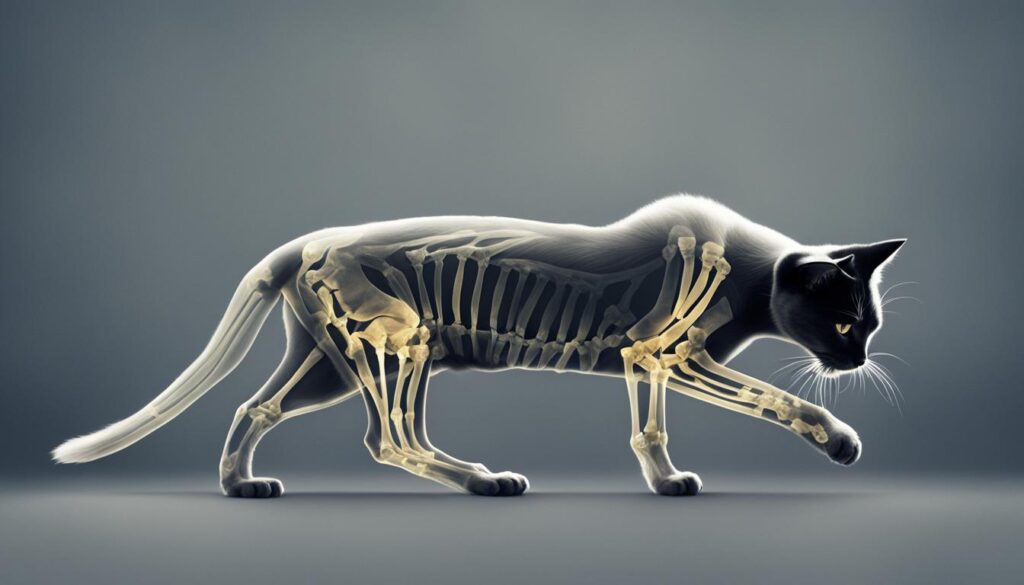
Environmental triggers also contribute to the development of genetic diseases in cats, particularly those with an epigenetic component. Exposure to certain chemicals, stress, and other environmental factors can interact with a cat’s genetic predisposition and trigger the manifestation of genetic diseases. These triggers can lead to the activation or suppression of specific genes, altering the cat’s susceptibility to certain genetic disorders.
“The combination of genetic factors and environmental triggers can have a profound impact on the development and progression of genetic diseases in cats. Understanding these factors is crucial in preventing, diagnosing, and managing these conditions.”
It is essential for cat owners and breeders to be aware of the genetic health issues that can affect cats and take proactive measures to minimize their impact. DNA testing and diagnosis play a crucial role in identifying genetic diseases in cats and determining the cat’s risk of developing or passing on these conditions. By understanding the genetic factors and environmental triggers that contribute to these diseases, we can work towards improving the overall health and well-being of cats.
Physical Examination and Diagnosis of Genetic Conditions in Cats
Diagnosing genetic conditions in cats requires a comprehensive physical examination by a veterinarian. During the examination, the vet will assess the cat’s overall physical condition, looking for any abnormalities or unique traits that may indicate the presence of a genetic disorder. This may involve observing the cat’s behavior, palpating the body for any abnormalities, and examining specific areas of concern. The vet may also take note of the cat’s breed and ancestry, as certain genetic disorders are more prevalent in specific breeds.
If the physical examination raises suspicions of a genetic disorder, further diagnostic tests may be recommended. One common tool used in the diagnosis of feline genetic disorders is genetic testing. This involves analyzing the cat’s DNA to identify the presence of specific gene mutations associated with genetic diseases. Genetic testing can provide definitive answers about the cat’s genetic health and help guide treatment and management options.
“Genetic testing plays a crucial role in diagnosing feline genetic disorders. It helps identify cats that should not be bred due to their risk of passing on the disease.”
Genetic Testing and Diagnosis
Genetic testing can be performed through veterinary diagnostic laboratories, which offer a range of tests for various inherited diseases in cats. These tests can determine whether a cat is affected by a specific genetic disorder or is a carrier. It is important to ensure that genetic testing is conducted under the supervision of a veterinarian and using a reputable laboratory to ensure accurate results.
In some cases, genetic test results can be linked to a cat’s permanent identification, such as a microchip number. This helps in accurate record-keeping and provides a reliable reference for future breeding decisions and monitoring the cat’s health.
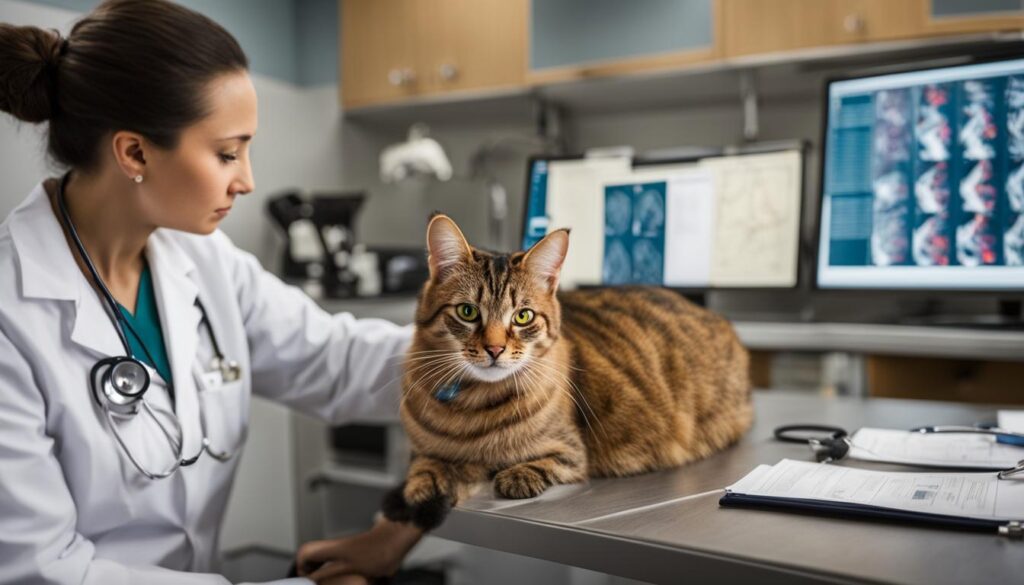
Importance of Early Diagnosis
Early diagnosis of genetic conditions in cats is crucial for effective management and treatment. Some genetic disorders may have subtle or overlapping symptoms, making it difficult to diagnose based solely on physical examination. Genetic testing can provide a definitive diagnosis, allowing for appropriate intervention and monitoring of the cat’s health.
By identifying genetic disorders early on, pet owners and veterinarians can implement strategies to minimize the impact of the disease on the cat’s quality of life. This may include dietary adjustments, lifestyle changes, and medical interventions tailored to the specific disorder.
Overall, physical examination coupled with genetic testing plays a vital role in identifying and diagnosing genetic conditions in cats. It enables veterinarians and pet owners to take proactive measures to manage these conditions, providing the best possible care for our feline companions.
Inbreeding and Genetic Disorders in Cats
Inbreeding and selective breeding practices have played a significant role in the prevalence of genetic diseases in cats. When close relatives are bred together, the risk of passing on harmful genes increases, leading to a higher incidence of genetic disorders. While selective breeding for specific traits is a common practice among breeders, it can inadvertently perpetuate the transmission of disease-causing genes. The consequences of these breeding practices can be seen in certain breeds that are more prone to genetic disorders.
One example of the impact of inbreeding is seen in the Maine Coon breed, which has a higher risk of spinal muscular atrophy (SMA). SMA is a genetic disorder that affects the muscles and motor neurons, causing weakness and progressive muscle wasting. Breeding cats that are carriers or affected by SMA can result in offspring with the disease, perpetuating the cycle of genetic disorders within the breed.
| Breed | Genetic Disorder | Prevalence |
|---|---|---|
| Maine Coon | Spinal Muscular Atrophy (SMA) | Higher risk due to inbreeding |
| Persian | Polycystic Kidney Disease (PKD) | Higher risk due to selective breeding |
| Siamese | Amyloidosis | Higher risk due to inbreeding |
It is important for breeders and owners to be aware of the potential risks associated with inbreeding and selective breeding. Responsible breeding practices aim to minimize the risk of genetic disorders by avoiding breeding individuals with known genetic diseases or carriers of disease-causing genes. Genetic testing can also play a crucial role in identifying carriers and affected cats, helping breeders make informed decisions to improve the overall health of their breed.
Conclusion
Well, my feline-loving friends, we’ve reached the end of our journey through the world of genetic disorders in cats. It’s been quite the exploration, hasn’t it? From understanding the intricate genetic makeup of our furry friends to delving into the management and prevention of these conditions, we’ve covered a lot of ground.
Genetic disorders in cats can be a daunting prospect, but fear not! With the right knowledge and a proactive approach, we can make a difference in the lives of our feline companions. Management is key, and genetic testing plays a crucial role in identifying affected cats and carriers. By working hand in paw with our trusted veterinarians and using reputable laboratories, we can ensure accurate diagnosis and make informed decisions for our beloved furry family members.
Prevention is always better than cure, and that holds true for genetic diseases in cats. Responsible breeding practices, coupled with DNA testing, help us avoid perpetuating disease-causing genes. And let’s not forget the importance of regular veterinary check-ups. Early detection is vital for effective management, so don’t be shy about scheduling those kitty wellness visits.
So, my friends, let’s continue to champion the health and happiness of our feline companions. By staying informed about the latest research and advancements in feline genetics, we can navigate the world of genetic disorders with confidence. Together, we can minimize the impact of these conditions and provide our cats with the best quality of life possible. Here’s to our purrfectly wonderful feline friends!
FAQ
What are genetic disorders in cats?
Genetic disorders in cats are conditions that arise due to abnormal genes that are passed down from one generation to another.
Why are pedigree cats more prone to genetic disorders?
Pedigree cats are more prone to genetic disorders due to selective breeding and inbreeding.
How can genetic testing help diagnose feline genetic disorders?
Genetic testing can determine whether a cat is affected by a specific genetic disorder or is a carrier, which is particularly important for breeding programs.
What are some common genetic disorders in cats?
Some common genetic disorders in cats include polycystic kidney disease (PKD) in Persian cats, hypertrophic cardiomyopathy (HCM) in Maine Coon and Ragdoll cats, and glycogen storage disease (GSD) in Norwegian Forest Cats, among others.
Can genetic diseases in cats be prevented or cured?
Genetic diseases cannot be completely prevented or cured, but their impact can be managed and minimized through breeding programs that focus on eliminating affected individuals and using DNA testing to identify carriers.
What role do breeding practices play in the prevalence of genetic diseases in cats?
Inbreeding and selective breeding practices can increase the risk of genetic disorders in certain breeds.
How are genetic disorders in cats diagnosed?
Diagnosing genetic conditions in cats usually begins with a thorough physical examination, and in some cases, genetic testing may be recommended to confirm a diagnosis or determine the cat’s risk of developing a genetic disease.
How can genetic diseases in cats be managed?
Treatment options for genetic diseases vary depending on the specific disorder and may include dietary adjustments, lifestyle changes, and medical interventions.

